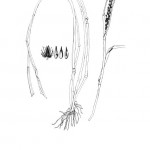Big Cenchrus
Cenchrus myosuroides
Poaceae
Description
Big Cenchrus is easy to identify in the field, presenting head high clumps with long seedheads full of spiny burs. This native bunchgrass has smooth, stout stems that grow from a decumbent knotty base. There is little branching, and the woody stems can reach 5 to 6.5 ft or 1.5 to 2 meters tall. The nodes are slightly swollen to swollen. Leaves are flat, scabrous on the upper surface, and have serrate margins. They are only up to 12mm wide but can go to 40 cm in length tapering from a flat base to an attenuate tip. The inflorescence can reach up to 16 inches or 40 cm long. Each acuminate spikelet has bristles united at the base forming a hard conical bur about 5 mm by 5 mm. Inner bristles are as long as the spikelet; outer bristles are shorter. The spiny burs will cling to wool and mohair, sticking to many objects. Big Cenchrus is a perennial, warm-season, native grass. It is a good grass for seeding old fields and denuded rangelands where only cattle are to be grazed. It is highly preferred by cattle but decreases with heavy grazing. While providing good grazing for livestock, it is only fair grazing for wildlife.Habitat
Grows on a variety of soils from sands to clays. Usually found growing in brushy ravines and ditches, along streams, roadsides, waste areas, and disturbed land.Images
Plant Characteristics
Duration: Perennial
Stem Texture: Hairless/Smooth
Growth Habit: Bunch grass, Grasses
Season: Warm
Distribution
 : 02 - Gulf Prairies and Marshes, 06 - South Texas Plains, 07 - Edwards Plateau, 10 - Trans-Pecos
: 02 - Gulf Prairies and Marshes, 06 - South Texas Plains, 07 - Edwards Plateau, 10 - Trans-Pecos
Distributions
Distribution refers to the ecological region in Texas that a plant has been found. You can also view a clickable map.
Book: Know Your Grasses (B-182)
Collection: Grasses


